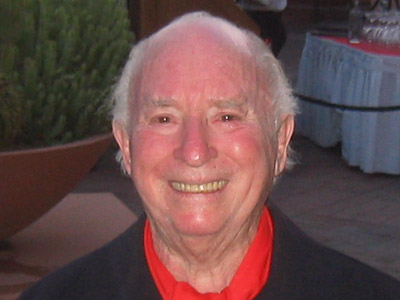
A very short giant in the world of comics died this morning at 3:15 AM in New York. From 1955 to 1986, Irwin Hasen drew the Dondi newspaper strip. Before that, he was a key artist in the early days of comics, working mostly for DC. He worked on many of their comics in the forties including Green Lantern but is probably best remembered as the co-creator of the character, Wildcat. His work on that feature was singled out by many of his peers (including Alex Toth) as outstanding for its expert storytelling and simplicity.
Irwin was born July 8, 1918 so he was 96 today when we lost him. He grew up in New York, started drawing when he was six and used to joke, "I never stopped and I never grew." (His height topped out at 5'2".) By a lucky coincidence, his family lived across the street from the National Academy of Design and his mother, seeing her son's obsession with art, took him over one day and enrolled him. He was by his own admission not the best artist in the world but no one could beat him when it came to hustling his work to potential buyers. His longtime friend Joe Kubert used to say that if people didn't love his work, they loved Irwin enough to buy some of it. He eventually got to be pretty darn good.
Irwin's earliest work in comic books seems to have been in 1940 for the studio of Harry "A" Chesler, who produced material for a number of publishers. By 1941, he was working for Sheldon Mayer at All-American Comics, a firm which later merged into DC Comics. Apart from a stint in the Army (most of it spent at Fort Dix, running the post newspaper), Irwin did almost all his work for DC until 1952 when — as he told it…
I was told, "You're a nice guy and everything, and we'll give you a couple of covers to do. But we've got Carmine Infantino, we've got Joe Kubert, we've got Alex Toth…" I was not really a comic book artist like these other guys. In the back of my head, for all my life, I'd wanted to do a comic strip in the newspapers. My idols were Roy Crane, who did Wash Tubbs, and Milton Caniff, of course.
Fortunately, not long after that, he was offered the chance to draw Dondi, a strip created and initially written by his friend and fellow cartoonist, Gus Edson. Irwin loved the job and ran with it, becoming the driving force behind its sales and success, and managing it after Edson passed away in 1966.
The above quote from Irwin is from a long interview I conducted with him at the 1999 Comic-Con in San Diego. An abridged version of it is on this site and I urge you to read Part 1 and then Part 2 to spend some time with this remarkable man. I was very fortunate that I was able to, then and at other conventions.
Irwin was funny and Irwin was irrepressible. I had him on several panels and he always arrived with a great funny (and sometimes, not-so-clean) anecdote that he was going to tell in response to whatever question I asked him, regardless of its content. One time, I asked him something innocuous like what kind of brush he used and Irwin spent the next ten minutes telling a roomful of surprised but delighted comic fans how when he was 15, a gangster named Frankie Carbo took a liking to him and paid for him to go to a prostitute and lose his virginity.
He also loved to teach and did a lot of that in the latter day of Dondi and after the strip ended…and he didn't stop drawing then. He kept at it, even creating an autobiographical graphic novel around the time he reached his nineties. As long as his health would allow it, he was a superstar on the convention circuit.
Those who love comics of the forties are no doubt saddened today to hear that our tiny supply of veteran creators from that era has been diminished today. Those who knew Irwin (or just his work) are saddened that there's no more Irwin Hasen. He was an absolute original, a very lovely man and about as dedicated a cartoonist as the business has ever known.